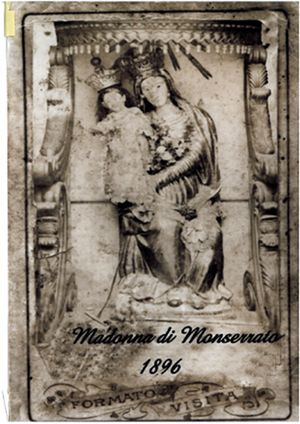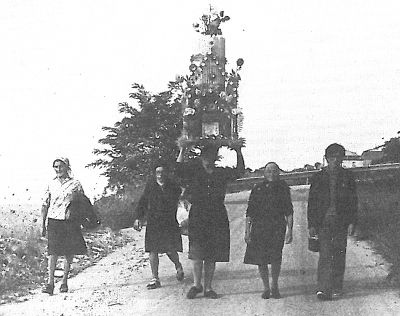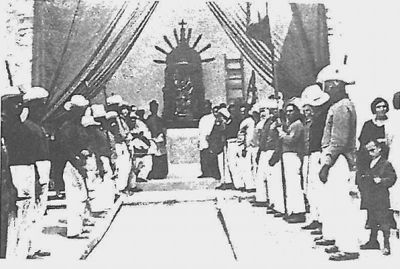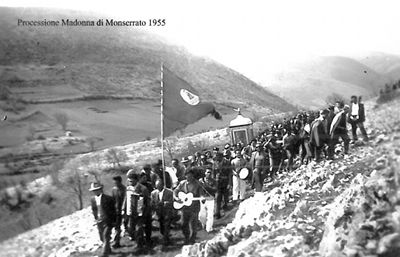Madonna of Monserrato celebration daysby Francesco TarlanoOrigins of the feast
According to one of the local historian, Caputi, Madonna of Monserrato feast was established after Council of Trent by archpriest Ettore Giliberti in an agreement signed in 1582, according to Caputi, «in the homonym church in Naples».
The pilgrimage to the sacred mountainThe last Sunday of August the mount is destination of pilgrimage by the faithful, performed to bring back Madonna of Monserrato statue from the chapel dedicated to her up in the city center, in view of the winter; in fact just the Tuesday after Easter the statue is taken back to the shrine on the mount. Madonna of Monserrato sanctuary in the past should be a building divided in three aisles and provided with six altars and a guest room for pilgrims, while currently is used as a smaller chapel. The pilgrimage to the sacred mountain, actually, already begins on Saturday night, after the blessing of the centa, a ship-shaped ex-voto made using wooden frame and covered by candles, carried by women of the village on their head, with the help of a cercine, or by hands. The centa represents the symbol of sin accumulated at home during the year which has to be purified in front of the statue of Mary and, after being blessed, it is took back to the city as propitiatory symbol.
Rituals and traditions during the pilgrimageOn the way some faithful perform ritual actions as sign of devotion, for example making the pilgrimage with bare feet, or to receive the remission of sins; in particular, before starting the climb to the mountain it is used to take a stone, whose dimensions are chosen in relation to the sins to atone, to lay it down at the foot of a wooden cross, next to the chapel of the Virgin; at the time of deposition of the stone, another stone is removed from the pile and then thrown down into the escarpment of the hill. The night between Saturday and Sunday the faithful get-together on the hill and spend the night there, some of them praying, other, especially young people, organizing picnic on the grass accompanied by the sound of guitars and other instruments, in a festive atmosphere of popular participation.
The pilgrimage to Grumento Nova and the Congregation of HalberdiersOn Sunday morning after mass, it begins the procession to Grumento Nova; the statue of Virgin is accompanied by the faithful and the band, escorted by halberdiers, the religious congregation of “soldiers of Madonna”. The foundation of this congregation dates back to 1852, in conjunction with the establishing of the cult of Spanish origin Madonna in Saponara.
Arrived in front of Capuchin convent, just before entering in the city center, the statue is moved from the palanquin to a golden throne and decorated with floral crowns; at the entrance of the village the procession is greeted with by Grumento’s people with enthusiasm and applauses in an atmosphere of great happiness and devotion and then it goes to the Mother Church of Grumento Nova.
Folklore during the celebration daysThe celebration week, from Friday before the feast to the following Monday, is characterized by the repetition of some traditional habits: in these days the people of the village is awaken by the sound of instruments of the band which roams through various quarters and streets of the city center and performs in the main square, while the evenings are enlivened by musical shows and the typical “fucarun’ ”, that are large wood fires made in each quarter on Friday evening. The young people, on the other hand, organize a football tournament among the different neighborhood teams, which ends on Monday with the long-expected match “Singles - Married”. The folklore that Grumento Nova lives in these days, in which every evening is enlivened by musical shows also by artists of world renown, culminates in the fireworks show on Monday night, that say goodbye to the summer and ends the festivities. (References: F. Ianneo, La Vergine del grano. Rito e spettacolarità sacra nella festa di Maria di Monserrato in Val d'Agri, 1983).
Copyright text (where there aren’t other references) by Francesco Tarlano; pictures by Domenico Florio |




 One of the most folkloristic occasions and most joined by Grumento Nova’s population, is the celebration feast of Madonna of Monserrato, an isolated hill which is about six kilometers from Grumento’s city center. Madonna of Monserrato has its roots from a Catalan Madonna called Madonna of Triumph, indicating the triumph of Christians over Muslims; by tradition, in fact, Christians to take away the statue from Saracen destruction, hid it on the top of Monserrato, hence the new topographic name.
One of the most folkloristic occasions and most joined by Grumento Nova’s population, is the celebration feast of Madonna of Monserrato, an isolated hill which is about six kilometers from Grumento’s city center. Madonna of Monserrato has its roots from a Catalan Madonna called Madonna of Triumph, indicating the triumph of Christians over Muslims; by tradition, in fact, Christians to take away the statue from Saracen destruction, hid it on the top of Monserrato, hence the new topographic name.
 The congregation still exists today, as heritage of local tradition, but its role is merely folkloristic. Originally halberdiers, which were chosen among the workers, wore an uniform of Hispanic taste brightly colored (green jacket, pants and white hat) and held halberds, flags and drums; they lined up at the sides of the palanquin on which it was placed the Madonna, in her defense, in front of Capuchin convent. Among them were distinguished several different positions: the captain, the carriers and the peace-holder; carriers offered themselves as volunteers to transport the statue to atone for their sins and obtain some graces. Nowadays the young people of the village perform these roles, to revive the charm of an ancient and solemn celebration.
The congregation still exists today, as heritage of local tradition, but its role is merely folkloristic. Originally halberdiers, which were chosen among the workers, wore an uniform of Hispanic taste brightly colored (green jacket, pants and white hat) and held halberds, flags and drums; they lined up at the sides of the palanquin on which it was placed the Madonna, in her defense, in front of Capuchin convent. Among them were distinguished several different positions: the captain, the carriers and the peace-holder; carriers offered themselves as volunteers to transport the statue to atone for their sins and obtain some graces. Nowadays the young people of the village perform these roles, to revive the charm of an ancient and solemn celebration.